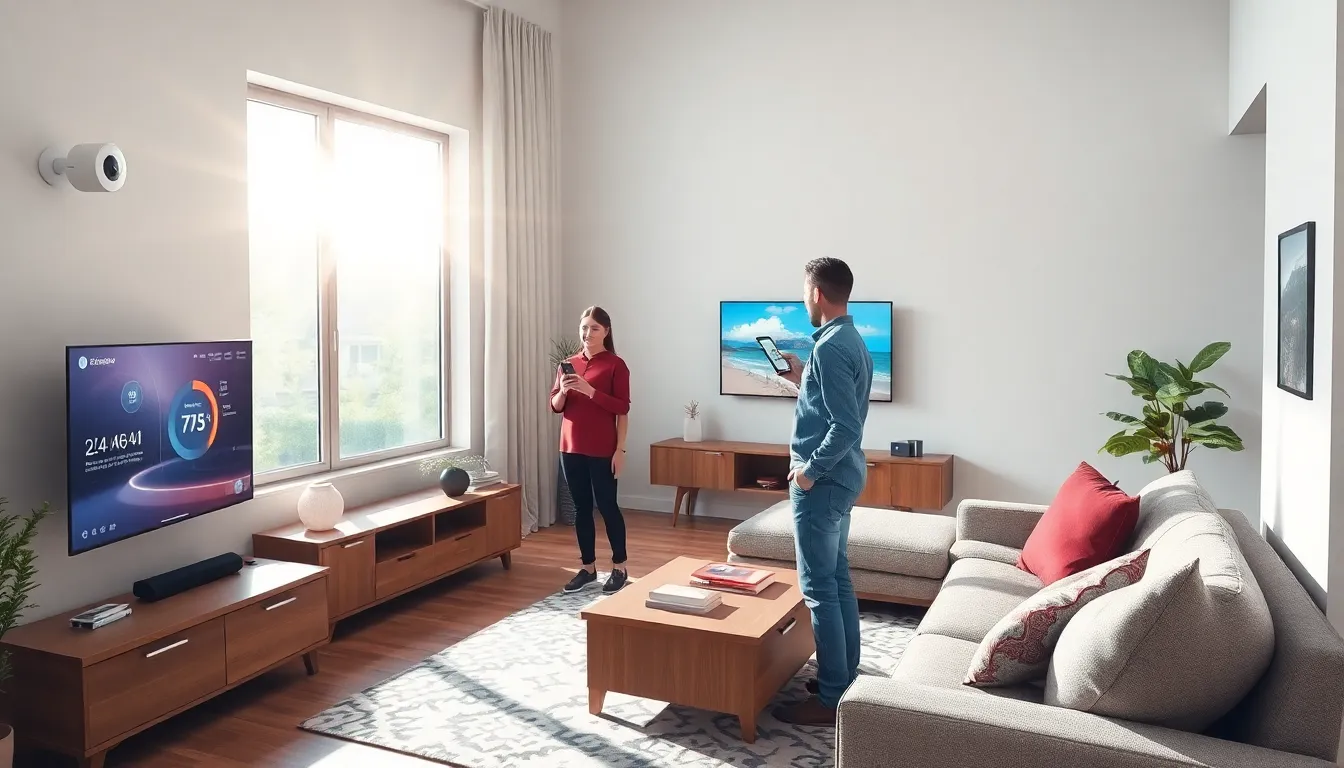Table of Contents
ToggleIn a world where your fridge can remind you to buy milk, connected living isn’t just a trend—it’s a lifestyle revolution. Imagine a home where your coffee brews itself as you stumble out of bed, still half-asleep, and your thermostat knows exactly when to kick into cozy mode. It’s not magic; it’s technology making life a whole lot easier.
Connected living seamlessly integrates smart devices into daily routines, transforming mundane tasks into moments of joy (or at least reducing the number of times you forget to turn off the lights). From smart speakers that play your favorite tunes to security systems that keep your home safe while you’re away, this interconnected world is designed to enhance comfort, convenience, and, let’s be honest, a bit of fun. Dive into the future and discover how connected living can turn your house into a smart home that practically runs itself.
Overview of Connected Living
Connected living embodies the integration of technology into everyday routines, enhancing the quality of life. Smart devices, such as thermostats, refrigerators, and lighting systems, communicate with one another to create an efficient ecosystem. Home automation simplifies daily tasks, allowing residents to manage their environments remotely or through voice commands.
Automation leads to greater energy efficiency, resulting in cost savings over time. Certain smart devices track usage patterns, adjusting settings automatically based on preferences. Security systems benefit from connectivity by providing real-time alerts directly to smartphones, allowing users to monitor their homes from anywhere.
Mobility plays a crucial role in connected living. Residents can control home features using tablets or smartphones, ensuring convenience regardless of location. Devices like smart speakers act as central hubs, streamlining commands for various systems within the home.
Social interaction becomes more accessible through connected living. Smart technology enables seamless communication among family members, even when they’re apart. Features like video calling integrate into home systems, fostering connections and enhancing relationships.
Connected living revolutionizes everyday experiences through technology. This integration not only enhances comfort and convenience but also elevates security levels, creating a holistic smart home environment. Exploring these innovations allows users to tailor their living spaces to their unique needs while benefiting from the efficiencies of modern technology.
Benefits of Connected Living

Connected living offers numerous advantages, enhancing daily experiences through technology. This integration creates a more efficient, enjoyable, and secure environment.
Enhanced Convenience
Smart devices significantly improve convenience in everyday life. Automation helps manage household tasks like adjusting lights and regulating temperatures. Residents can control appliances remotely using smartphones, avoiding the need to be physically present. Voice commands simplify operations, allowing hands-free management of connected devices. For instance, a user picking up groceries can instruct their smart oven to preheat, preparing for cooking once they arrive. These conveniences save time and streamline daily routines, ultimately promoting a more comfortable lifestyle.
Improved Security
Connected living enhances home security through various integrated features. Smart cameras and doorbells provide real-time monitoring, allowing residents to view activity outside their homes from their devices. Security systems equipped with motion sensors send alerts directly to smartphones, enabling immediate responses to potential threats. Automated lighting simulates presence, deterring intruders when residents are away. These innovative security measures contribute to peace of mind, ensuring that inhabitants remain well-protected without constant vigilance. Overall, connected living fosters a safer environment tailored to individual safety needs.
Technologies Driving Connected Living
Technologies play a crucial role in shaping connected living environments. Two key components are the Internet of Things (IoT) and smart home devices, which transform everyday interactions.
Internet of Things (IoT)
IoT connects a multitude of devices, enabling seamless communication between them. Smart appliances collect and share data, creating a cohesive network that enhances user experience. For instance, a smart thermostat adjusts temperatures automatically based on user preferences and energy consumption patterns. Sensors monitor home conditions, ensuring optimal comfort and efficiency. Moreover, IoT facilitates remote management, allowing users to control their devices from anywhere via mobile apps. This connectivity not only streamlines household management but also contributes to energy savings and reduced utility costs. Ultimately, IoT represents the backbone of connected living, laying the groundwork for an intelligent and responsive home environment.
Smart Home Devices
Smart home devices fundamentally reshape how individuals interact with their living spaces. From smart lighting systems to automated kitchen appliances, these devices enhance everyday tasks. Users can control lighting through voice commands or schedules, ensuring efficiency and convenience. Automated coffee makers brew fresh coffee at dawn, starting the day on a positive note. Smart security systems provide real-time alerts, giving residents peace of mind when away from home. Users benefit from features like smart locks that allow secure access management through phones. Together, these devices create an integrated ecosystem that boosts comfort, convenience, and security, making connected living an increasingly viable option for homeowners.
Challenges in Implementing Connected Living
Implementing connected living presents specific challenges that hinder widespread adoption.
Privacy Concerns
Data privacy emerges as a significant challenge in connected living. Smart devices often collect personal information, raising concerns about unauthorized access to sensitive data. Personal habits, preferences, and routines monitored by these devices could lead to unwanted tracking. Vulnerabilities in device security may expose user data to potential breaches. Consumers frequently worry about how their information is used and shared, prompting hesitance in fully embracing smart technology. Furthermore, regulations on data privacy, such as GDPR, create a complex landscape for manufacturers, necessitating compliance that may delay product rollouts.
Interoperability Issues
Interoperability poses another challenge in the landscape of connected living. An array of devices from various brands often struggle to communicate effectively. Compatibility issues can leave users frustrated, as products fail to operate synergistically within a connected ecosystem. The lack of standard protocols makes achieving seamless integration difficult. Furthermore, consumers might need to invest in multiple hubs to facilitate connections between different devices. Investing time and resources into managing these complexities may deter users from engaging fully in smart living environments. Without clear solutions to these interoperability hurdles, the potential of connected living risks remaining unfulfilled.
The Future of Connected Living
The future of connected living promises to reshape everyday experiences through technology integration. Current advancements signal a burgeoning landscape where connected devices play a central role.
Trends to Watch
Enhanced connectivity leads the way as more smart devices become commonplace in homes. Consumers increasingly prioritize energy efficiency, driving demand for smart thermostats and lighting systems. Integration of artificial intelligence enables predictive functionality, allowing systems to adapt to user preferences. Voice-activated assistants also gain popularity, streamlining communication between users and devices. Furthermore, seamless interoperability with various platforms marks a significant shift, allowing diverse products from multiple brands to work in harmony. Increased focus on data security ensures smart device manufacturers implement robust measures to protect consumer information.
Predictions for Growth
Significant growth in the connected living sector is expected over the next five years. Analysts project the smart home market will reach $174 billion by 2025, reflecting a compound annual growth rate of roughly 25 percent. Products designed for home security will see heightened interest, addressing consumer concerns about safety and privacy. Increased automation will drive adoption, as residents seek convenience and efficiency in their daily routines. Additionally, more households will embrace energy-efficient solutions, responding to environmental sustainability trends. This shift toward digital integration will forge new opportunities for businesses, resulting in innovative products that cater to evolving consumer needs.
Connected living is set to redefine how individuals interact with their homes and daily routines. As technology continues to evolve the integration of smart devices offers unprecedented levels of comfort and security. The potential for automation enhances not just convenience but also energy efficiency and safety.
While challenges like privacy concerns and interoperability remain, the future looks promising. With advancements in artificial intelligence and improved device compatibility, connected living will likely become more accessible and appealing. Embracing this lifestyle can lead to a more streamlined and enjoyable home experience, making it an exciting frontier for homeowners everywhere.




